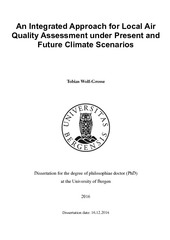| dc.contributor.author | Wolf-Grosse, Tobias | |
| dc.date.accessioned | 2017-01-03T10:42:46Z | |
| dc.date.available | 2017-01-03T10:42:46Z | |
| dc.date.issued | 2016-12-16 | |
| dc.identifier.uri | https://hdl.handle.net/1956/15335 | |
| dc.description.abstract | Local circulation features in complex terrain are often not resolved in today’s mesoscale numerical weather prediction and research models. For urban areas embedded in complex terrain a prediction of the local circulation is, however, of high importance, as it can lead to adverse conditions for the urban population. One example is local stagnation of the flow in the stably stratified valley atmosphere, also referred to as cold air pools. Under such conditions even small to medium sized cities can experience exceedances of legislative thresholds for urban air quality. In this study I therefore explore and apply a novel integrated approach for micro-climate scenario studies in complex terrain, reflecting a new type of statistical dynamical downscaling based on Large Eddy Simulations (LES). The recurring wintertime urban air pollution events in Bergen, Norway, serve hereby as a concrete case-study. The work presented consists of four scientific manuscripts. The first manuscript describes the local observational perspective. I used measurements with an MTP-5HE microwave temperature profiler to characterise the local temperature inversions and their connection to the urban air pollution episodes. The study revealed new information on the occurrence and structure of the temperature inversions in the Bergen valley. Temperature inversions are a common phenomenon in Bergen, especially during the winter. For example, during December 2012 and February 2013, more than 60% of the measurements taken under fair weather conditions (no rain or clouds below 600 m) between 18:00 and 8:00 UTC, showed inversions. The average depth of persistent temperature inversions that are lasting longer than two hours is mostly below 270 m, with a maximum in the distribution at 170 m. Both, NO2 and PM2.5 air pollution episodes are highly associated with persistent temperature inversions that are around 220 m deep. Such long and consistent studies of the lowlevel temperature inversions with microwave profilers are scarce. This study also served as the observational basis for all further work described here. The second and fourth manuscripts describe the large-scale and long-term perspective. We developed a simple atmospheric circulation proxy that empirically links the essentially local phenomenon of urban air pollution inside the Bergen valley to the circulation above it. This allowed us to assess the long-term variability of the occurrence of the air pollution episodes, both forward and backward in time. We also analysed the relevance of the large-scale circulation for the air pollution episodes in order to gain a better understanding of their external steering parameters. Air pollution episodes in Bergen cluster during some winters and are almost absent during others. The recurrence time for consecutive winters with such clustering was approximately 10 – 15 years but varies strongly. We found no change in their future potential occurrence. Air pollution episodes are often connected to certain persistent features of the large-scale flow. This persistence is, however, not necessarily steered by anticyclonic blockings directly over Western Norway, contrary to prior assumptions. The third manuscript describes the local modelling perspective. Based on the knowledge of the reduced parameter space of the circulation above the Bergen valley during observed air pollution episodes, we studied the local circulation during these events. We used high resolution LES simulations over a comparatively large domain. The study revealed the relevance of the interplay between the circulation forced by the large-scale flow and a local land breeze in the Bergen valley. This local breeze is controlled by the warm fjord and cold land temperature differences. Certain regimes of this large-to-small scale interaction worsen the local stagnation and hence increase the accumulation of the locally emitted pollutants. Parts of the above described methodology were exploited in an applied research project. We investigated the impact of ships in the Bergen harbour on the local pollutant concentrations during air pollution episodes. Further research and development in this direction are highly valuable for impact assessments of future infrastructure projects. The methodology is computationally demanding. However, the continuing growth of available computing facilities and further developments of the LES models will improve its accessibility and realism. | en_US |
| dc.language.iso | eng | eng |
| dc.publisher | The University of Bergen | en_US |
| dc.relation.haspart | Paper I: Wolf, T., I. Esau, and J. Reuder (2014), Analysis of the vertical temperature structure in the Bergen valley, Norway, and its connection to pollution episodes, J. Geophys. Res. Atmos., 119(18), 10,645-10,662. The article is available at: <a href="http://hdl.handle.net/1956/9478" target="blank">http://hdl.handle.net/1956/9478</a> | en_US |
| dc.relation.haspart | Paper II: Wolf, T., and I. Esau (2014), A proxy for air quality hazards under present and future climate conditions in Bergen, Norway, Urban Clim., 10, 801–814. The article is available in the main thesis. The article is also available at: <a href="http://dx.doi.org/10.1016/j.uclim.2014.10.006" target="blank">http://dx.doi.org/10.1016/j.uclim.2014.10.006</a> | en_US |
| dc.relation.haspart | Paper III: Wolf-Grosse T., I. Esau and J. Reuder, Sensitivity of local air quality to the interplay between small- and large-scale circulations: a Large Eddy Simulation study, Atmos. Chem. Phys., 17(11), 7261-7276. The article is available in the main thesis. The article is also available at: <a href="https://doi.org/10.5194/acp-2016-892" target="blank">https://doi.org/10.5194/acp-2016-892</a> | en_US |
| dc.relation.haspart | Paper IV: Wolf-Grosse T., I. Esau and J. Reuder, The large scale circulation during air quality hazards in Bergen, Norway. The article is not available in BORA. | en_US |
| dc.title | An Integrated Approach for Local Air Quality Assessment under Present and Future Climate Scenarios | en_US |
| dc.type | Doctoral thesis | |
| dc.rights.holder | Copyright the author. All rights reserved | en_US |
| dc.identifier.cristin | 1411635 | |
